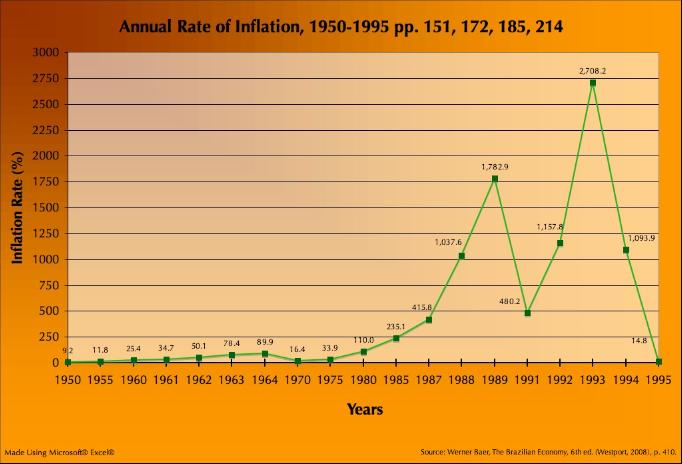Sustained Economic Growth During World War II …
Brazil suffered a depression after the crash of 1929, yet emerged from it much sooner than England or the United States, sustaining its recovery through World War II. At this time production was on the rise and with war stipulated technology and equipment from the United States, Brazil was able to modernize. Increased transportation and a turn toward domestic production instead of imports helped to accelerate Brazil’s growth. This graph clearly shows in both current and constant prices the initial depression in the GDP, but then sustained growth throughout the Second World War period.
- What were the effects of World War II on the Brazilian economy?
… Followed by an Inflation Crisis

A careful look at this graph shows the story of the Brazilian economy’s inflation. The graph shows inflation rising steadily through the second half of the twentieth century, spiking in 1989 and 1993. The slow rise of inflation had many causes, much can be attributed to a series of presidents who ignored or worsened the country’s economy. The spikes in the late 1980s and early 1990s correlate with José Sarney’s presidency and the Cruzado Plan in 1988 and 1989, followed by continuing economic hardship and instability for several years until there was a sharp drop in inflation due to Fernando Henrique Cardoso’s Plano Real.
- What aspects of presidential policies and international factors in this period allowed inflation to continue to rise to such an extent it became part of the Brazilian norm?
- Apart from economic hardships, what were other trends in the 1980s and early 1990s that characterized such a difficult period in Brazil’s recent history?
Further Reading
- Werner Baer’s The Brazilian Economy: Growth and Development explains the history of the country’s economy, including the political consequences of the upheaval in the middle of the 20th century.
Sources
- Goldsmith, Raymond. Brasil 1850–1984: Desenvolvimento Financeiro sob um Século de Inflação. São Paulo: Banco Bamerindus do Brasil, 1986.

